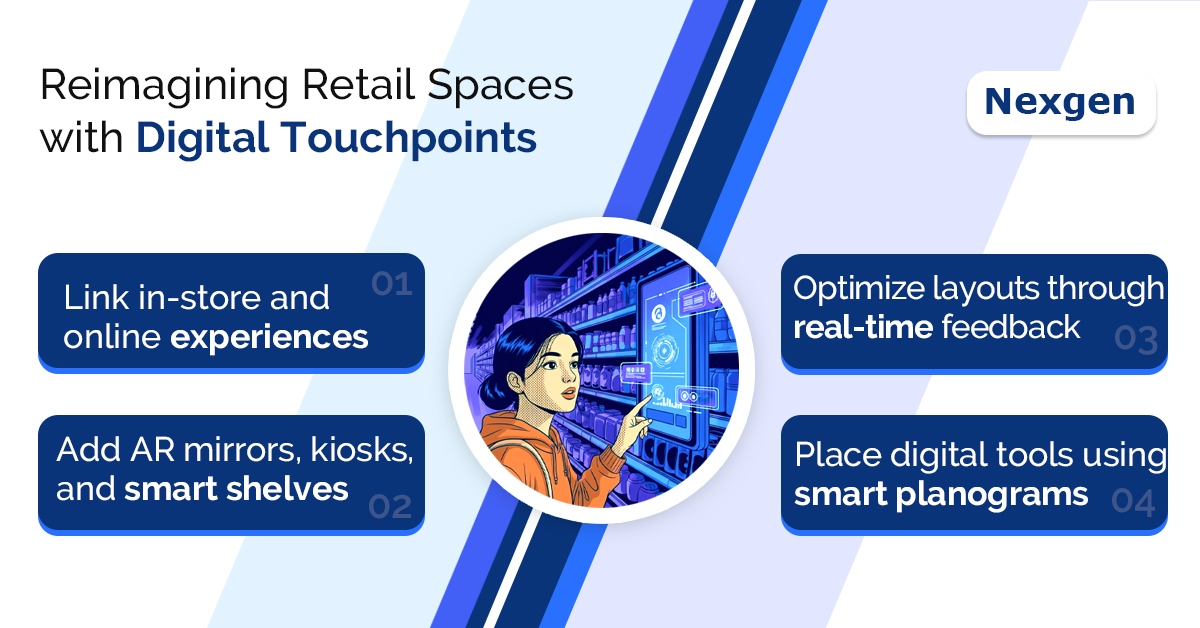Nowadays, digital technology is no longer confined to online shopping, it has become an integral part of physical stores. The modern shopper expects a seamless blend of the digital and physical worlds, where technology enhances in-store experiences and creates convenience. To meet this demand, retailers are reimagining their store layouts by incorporating digital touchpoints with the help of planogram services to elevate customer engagement and streamline operations. There are a few ways that digital touchpoints can be used in store layouts. Some of the most common uses include:
- Providing product information: Digital touchpoints can be used to provide customers with more information about products. This could include things like product reviews, videos, and demos.
- Enhancing the shopping experience: Digital touchpoints can be used to create a more engaging and interactive shopping experience. This could include things like interactive games, virtual try-on experiences, and personalized recommendations.
- Driving sales: Digital touchpoints can be used to drive sales by providing customers with unique offers and promotions.
Strategies for Incorporating Digital Touchpoints into Store Layouts
- Map customer journeys:Understand how customers navigate your store and identify key areas where digital touchpoints can enhance their journey. For instance, placing digital signage near entrances with the help of planograms can highlight promotions. Retailers can also install interactive kiosks in high-traffic areas to provide product details.
- Leverage planograms for layout optimization:Use planograms to strategically position digital touchpoints alongside physical displays. This ensures seamless integration and prevents overcrowding. For example, smart shelves can be placed near checkout counters for last-minute add-ons. Retailers can place AR/VR stations in designated experiential zones to entice shoppers.
- Prioritize user-friendly design:Ensure digital touchpoints are intuitive and accessible. Provide clear instructions and maintain a consistent design language across devices for a cohesive brand experience.
- Integrate omnichannel features: Enable cross-channel functionality, such as, letting customers order online and pick up in-store or synchronizing loyalty programs across physical and digital platforms.
- Adapt to real-time feedback: Monitor usage data and customer feedback to identify what works and what does not. Continuously refine the placement and functionality of your digital touchpoints.

Examples of Digital Touchpoints in Action
- Fashion retail: A clothing store uses AR mirrors to let customers virtually try on outfits, reducing fitting room congestion and enhancing the shopping experience.
- Grocery stores: Smart shelves display dynamic pricing and suggest recipes based on products in stock.
- Electronics retail: Interactive kiosks provide in-depth product comparisons, helping customers make informed decisions.
- Convenience stores:. Self-checkout kiosks reduce lines, while digital signage promotes quick snacks or combo deals.
Overview of Nexgen POG
Nexgen offers store-specific planograms for clients that optimize sales and achieve category objectives. We create customized planograms for your business to ensure that these are better aligned with your goals and merchandising strategies. Our expertise in planogram automation helps us build planograms faster, better, and consistently. Whether it is creating a planogram from scratch, or a typical reset, we have the knowledge, tools, and experience to get the job done for you.
Get Your Free Trial Now!